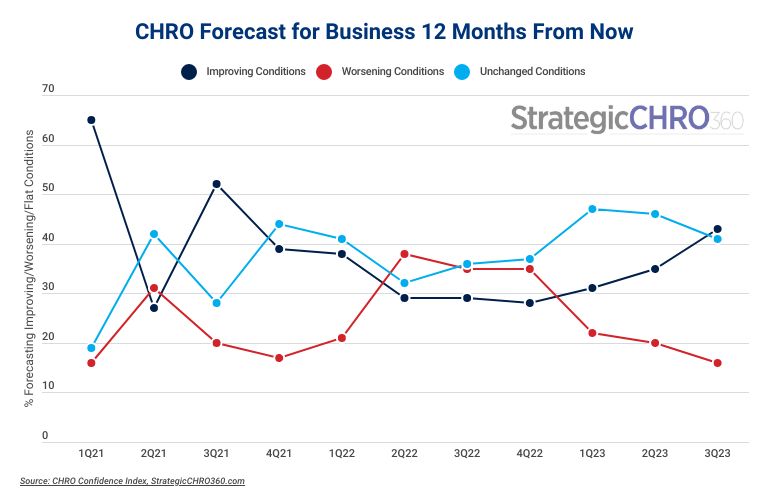If you asked any member of the C-Suite about their greatest challenges these days—and in the past few years—labor would certainly find its way near the top, if not at the top.
At least, that’s according to our C-Suite Confidence Index series, which survey CEOs, CFOs, CIOs, CHROs and board members on a regular basis throughout the year to measure sentiment in current business conditions and what they see coming in the months ahead.
A top view of StrategicCHRO360’s CHRO Confidence Index reading in July shows a growing proportion of America’s HR chiefs are expecting business conditions to improve by this time next year—at 43 percent. That’s a jump of 23 percent since we last polled them in Q2.
But that uptick comes with an important caveat: CHROs say current business conditions have been on the decline since the start of the year, and the labor market is one of the reasons why.
When asked to rate their assessment of current conditions on a 10-point scale, where 10 is Excellent and 1 is Poor, the 194 CHROs polled last week gave them an average rating of 5.9. That’s an 8 percent drop from what they saw happening in Q2, and a 12 percent drop from where we started the year.
CHROs say talent cost and availability remain significant concerns for business—and CEOs echoed the same concerns in sister publication Chief Executive’s latest survey of that community.
Three-quarters of the CEOs polled in August said that hiring challenges haven’t eased since last year—despite the Fed’s best efforts—and 35 percent of those say it’s actually gotten more difficult. CHROs agree: 73 percent said hiring hadn’t eased, and 39 percent said it had in fact gotten more difficult in the past year.
If there is any expectation that labor availability will increase in the quarters ahead—see recent reports of a softening market—there is still the issue of labor cost. Once again, three-quarters (77 percent) of CEOs say the pay increases requested by employees remain large—and 33 percent say those numbers are in fact still rising.
When we asked CHROs, the response was even more pronounced: 91 percent said the pay increases remain large—and 56 percent said the increases requested by employees are higher than last year.
“Employees are feeling the cost of rising prices and are expecting higher increases and more flexibility. Unfortunately, the company is also feeling higher prices and is unable to provide higher increases,” said a CHRO at an industrial manufacturing company.
While important, salary is only one of the many benefits companies can offer employees. Yet, the pace at which wages are growing is having an impact on other HR initiatives that help foster a strong culture, the survey found. The proportion of CHROs who plan to increase their investment in their workforce (outside of compensation)—think learning and development, for instance—dropped to 52 percent this quarter, from 59 percent in Q2. And only half of those said the increase would be sizeable.
That number has been declining since the beginning of the year and is now back to where it was at this time last year, most likely as a result of rising pay and increasing rates tightening profitability margins.
The Year Ahead
When asked about how all of those elements are impacting the company’s bottom line, fewer CHROs this quarter said they expected profits to be up by this time next year (down 12 percent to 51 percent from 58 percent in Q2). And we found a 14 percent decrease in the proportion of CHROs who expect revenues to be up by Q3 of 2024, 61 percent vs. 71 percent last quarter.
“We are limited by the availability of a consistent workforce,” said one CHRO, echoing peers.
“Our wages are competitive and higher than most companies in the same industry and in this general area, [but] attracting talent can be challenging,” said a CHRO in the restaurant space. “But what is even more challenging is getting people who actually want to work and excel in their roles so they can increase their skill set and expand their knowledge base.”
It’s no surprise, then, that when asked to forecast what they expect to see 12 months from now, CHROs rated their forecast for business a 6.4, down 5 percent from 6.7 last quarter—and down 7 percent since the beginning of the year.
Still, it has been worse.
This time last year, the Index hit a bottom 5.6 and 5.2, for future and current conditions, respectively. At the time, labor shortages, increased turnover, growing inflation and the expectation of a recession all combined to drive fear for the months ahead. This quarter, while most of the HR chiefs we polled acknowledged that the economy was improving, many said labor challenges will continue to restrict growth.
Nevertheless, 59 percent are still planning to increase hiring over the coming year (a stable proportion from the 58 percent who said the same last quarter), though a third also expect turnover to increase during that period.
The Future of Work
There’s been a lot of talk about the benefits of different work models, and there is still a tug-of-war between proponents of each camp—and their employees.
So, this quarter, we asked CHROs if, in their experience, the work model mattered to new candidates and existing employees. The overwhelming response was yes.
On a 10-point scale, CHROs rated the importance of workplace flexibility a 7.7 for new candidates, and 7.2 for existing employees—both Very Important according to our scale labels.
That could explain that two-thirds of those polled reported either having adopted a more flexible work environment or being in discussion to do so in the near future. Only 11 percent said that after being remote, they had now reverted to in-office for most employees.
Questions? Comments?
There are a lot of challenges for business leaders to overcome, and CHROs play a pivotal role in helping their organizations grow.
Some of the CHROs participating in our survey shared tips and concerns with the HR community. If you would like to address any of those comments or support peers by sharing strategies you’ve implemented—those that worked, those that didn’t—we invite you to send an email to Research@ChiefExecutiveGroup.com. We’ll collate and anonymize the responses and provide respondents with a report of these findings.
Compensation and Benefits:
- Curious if other companies are employing any pay transparency practices in excess of what is legally required? If nothing now, are they considering being more transparent? How are they preparing employees and leaders for this added transparency?
- Due to inflation, cost has gone up and revenue growth is slowing down. In this scenario, are the CHROs planning to continue to have annual merit increase cycle this year?
- How are you managing wage compression with new hires coming in at higher wages than ever, and what do you do with current staff who might not be adequately paid according to new industry standards?
- Are you doing anything differently with perks and benefits, other than increase wages?
- What are you seeing in benefit usage and costs overall (e.g., health claims, GLP-1 drugs)?
- Pay transparency is becoming a challenge for us. How are other companies managing through setting pay bands and ensuring they are adhered to?
- Are you seeing an increase in claims of work stress?
DEI:
- How have you changed your DEI strategy since the Supreme Court decision?
- Does DEI have a role in creating a more engaging environment in your company?
- Given the polarization on DEI-related initiatives, how are companies approaching their commitment to DEI and will there continue to be a concerted effort to ensure diverse representation across all levels?
Productivity and Work Models:
- How are you monitoring and driving for increased productivity?
- I would like to see more specificity around components of return to office / flex working plans
- How have you responded to demands of employees around remote, hybrid, onsite?
- What has been your turnover rate in this new environment, and are you still having to conduct layoffs?
- Assuming the pace of your business is ever-increasing, how well are your employees adapting to that?
Retaining / Attracting Talent:
- What changes are you making in the training and retention with generation Y and Z?
- What other ways are you attracting new talent and retaining existing?
- Employee retention in a manufacturing setting: How do you get people to return to work (and keep coming back)?
About the CHRO Confidence Index
The CHRO Confidence Index is a pulse survey of U.S.-based CHROs and HR executives at organizations of all types and sizes on their perspective of the economy and how policies and current events are affecting their companies and strategies. Every quarter, StrategicCHRO360 asks participating CHROs about their top issues and challenges for the months ahead. The results are published on StrategicCHRO360.com and a report is distributed to participants.








